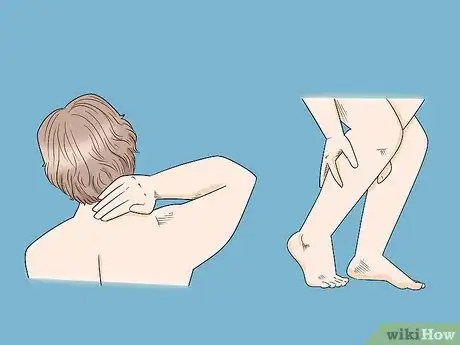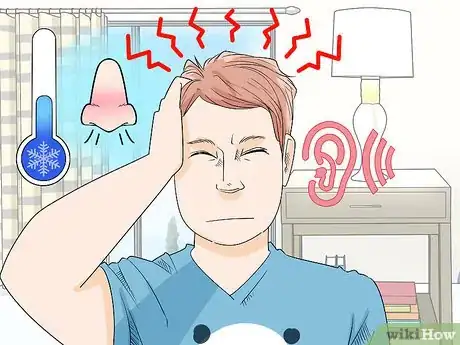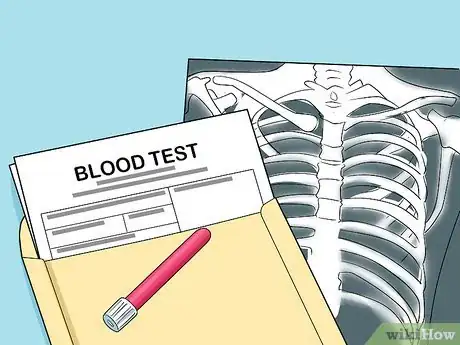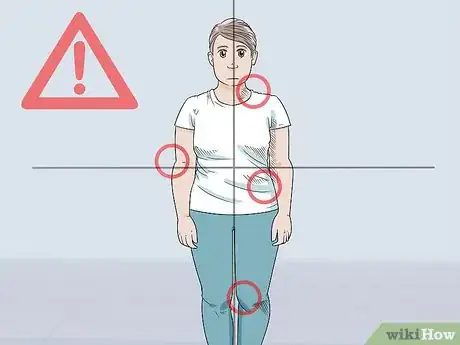This article was co-authored by Joel Giffin, PT, DPT, CHT. Dr. Joel Giffin is a Doctor of Physical Therapy and the Founder of Flex Physical Therapy in New York, New York. With over 15 years of experience as a Certified Hand Therapist (CHT), Dr. Giffin treats the whole body and specializes in rehabilitation of the hand and upper extremities. He has treated Broadway theater performers backstage at shows such as The Lion King, Sleep No More, Tarzan, and Sister Act. Flex Physical Therapy also specializes in occupational and pelvic floor therapy. Dr. Giffin earned his Master’s degree in Physical Therapy with honors from Quinnipiac University and received his Doctor of Physical Therapy (DPT) degree with distinction from Simmons College. He is a member of the American Physical Therapy Association and the American Society of Hand Therapists.
There are 10 references cited in this article, which can be found at the bottom of the page.
This article has been viewed 35,881 times.
Fibromyalgia is a condition characterized by chronic muscle pain and weakness. It is commonly associated with symptoms including widespread muscle pain, fatigue, and problems with sleep and concentration. While your symptoms may indicate you have fibromyalgia, the best way to diagnose this chronic condition is to consult with your healthcare provider regarding medical tests.
Steps
Recognizing Fibromyalgia
-
1Determine your risk for developing fibromyalgia. You may be at higher risk of fibromyalgia if you are a woman, have a family history of fibromyalgia, are middle-aged, or suffer from a rheumatic disease such as rheumatoid arthritis or lupus. Review your medical history and talk to your family to check your personal risk factors.[1]
- Symptoms may also sometimes begin after a physical trauma such as surgery or infection.
-
2Monitor muscular symptoms including spasms, tightness, and chronic pain. The most prominent fibromyalgia symptoms are the pain and fatigue of your entire muscular systems. Keep track of how often you experience pain or irregular sensations in your muscles, such as numbness, tingling, burning, twitching, or itching. Write your symptoms down if need help keeping track of their frequency or severity.[2]
- Chronic, widespread muscle pain is often characterized as a constant dull ache that lasts for an extended period of time on both sides of your body, and above and below your waist.
- Muscle pain may also lead to tingling in the limbs, stiffness, or soreness in muscles that have been at rest. For example, you may feel unable to walk or bend after sitting for a long time.
Advertisement -
3Keep track of how tired you are and how well you sleep. Fibromyalgia is often accompanied by fatigue and decreased energy levels all day long. Take note of how often you feel tired throughout the day, and check to see if you are sleeping completely through the night. Many fibromyalgia patients also struggle with insomnia due to the pain.[3]
- Even patients who get a full night’s sleep may experience fatigue with fibromyalgia.
-
4Consider times you struggled to remember things in your daily life. Feelings of mental fogginess, also known as “brain fog,” may indicate you are struggling with fibromyalgia. This is characterized by being slow to recall basic things such as names or directions in your daily life.[4]
- Trouble sleeping or fatigue coupled with chronic pain is an indicator of fibromyalgia. If you experience fatigue or trouble sleeping but do not have muscular pain, you are likely dealing with a different condition.
-
5Check for sensitivity to external stimuli. Fibromyalgia can cause sensitivity to noise, specific foods, odors, bright lights, cold temperatures, and medications. If you notice yourself having adverse reactions to any of those in addition to muscular pain, you may want to talk to your doctor about fibromyalgia.[5]
- These sensitivities can often lead to severe headaches. Migraines are a common problem for patients with fibromyalgia.
-
6Keep track of any digestive problems you may have. Common abdominal symptoms include bloating, nausea, constipation, diarrhea, abdominal pain, and frequent, urgent bouts of urination. If you notice that any of these occur regularly throughout the day or week, it may be an indicator of fibromyalgia.[6]
- Some patients with fibromyalgia may develop or be diagnosed with irritable bowel syndrome (IBS).
-
7Talk to your doctor to eliminate other possible conditions. Unfortunately, fibromyalgia shares symptoms with other conditions. This means that your doctor should eliminate those conditions as possible causes for your symptoms. Your doctor will want to do a physical examination and will likely order diagnostic tests.
- Your doctor may want to do a blood test, as well as nerve tests.
Getting a Medical Diagnosis
-
1Make an appointment with your healthcare provider. You should contact your healthcare provider as soon as you notice any severe or chronic muscle pain or fatigue. Let them know what symptoms you have or are currently experiencing. You should also tell your healthcare provider if you have any risk factors for or a family history of fibromyalgia.[7]
- You can talk to your general practitioner about your symptoms, or you can visit an internist or a rheumatologist.
-
2Have your doctor test for other conditions with similar symptoms. Some other conditions have symptoms to fibromyalgia. Your doctor can perform a series of tests to rule out these other conditions, such as blood tests, X-rays, and biopsies.[8]
- There are several conditions that have similar symptoms to fibromyalgia, but you shouldn't be worried about a long list of possible causes. Talk to your doctor about which of these conditions match your specific symptoms. The doctor will then determine if one of those conditions is causing your symptoms, or if you may have fibromyalgia.
-
3Have your doctor test all your body for constant pain. According to rules put in place by the American College of Rheumatology (ACR) in 2010, fibromyalgia can be diagnosed by determining whether you experience constant pain in the 4 quadrants of your body. These quadrants are divided into the left and right sides of your body, and above and below the waist.[9]
- For a diagnosis to be made, you need to have experienced pain in a quadrant for a minimum of 3 months.
- Your doctor may also test for tenderness in the neck, between your shoulder blades, on your elbows, upper hips, inner knees, and the back of your head. These are all areas commonly associated with fibromyalgia.
-
4Ask your doctor to check for related conditions. Patients with fibromyalgia also commonly experience depression, anxiety, and irritable bowel syndrome. Talk to your doctor about all of your physical and mental symptoms to see if you should be screened for any of these conditions in addition to fibromyalgia.[10]
Managing Fibromyalgia Symptoms
-
1Talk to your doctor about taking pain relievers. Over-the-counter pain medication including acetaminophen, ibuprofen, and naproxen sodium may all be helpful in managing your fibromyalgia pain. Talk to your doctor about which medication is right for you. Ask your doctor about what dose you should take and how often you should take it, since they may prescribe a different dose than the packaging suggests.[11]
- If you find that over-the-counter drugs aren’t helping, let your doctor know. They may be able to provide you with prescriptions medications commonly used to treat fibromyalgia including painkillers.
-
2Work with a physical therapist to improve strength and stamina. A physical therapist can provide you with an exercise routine that will help you manage your fibromyalgia symptoms. Talk to your healthcare provider to get a recommendation for a physical therapy center in your area that specializes in working with fibromyalgia patients.[12] [13]
- Likewise, an occupational therapist can help you make adjustments to your workplace layout and routine that may help make your symptoms more manageable throughout the day.
-
3Incorporate strength training into your daily exercise routine. Both strength training and aerobic activity are important for managing fibromyalgia. Strength training, in particular, can help manage muscle stiffness and soreness. Start with 1 pound (0.45 kg) to 13 pounds (5.9 kg) weights and build up slowly with common strength exercises like bicep curls, squats, and bench presses.
- Try to give your body a day to rest in between every strength training workout.
- Shorten the range of motion if you feel it is to painful or strenuous to complete a full exercise. You can even talk to a physical therapist about the right exercise form for you to help accommodate your fibromyalgia.
- You may want to try activities like water aerobics, yoga, and Pilates, which can help you build strength with a lower impact to your body.
- Remember that the point of strength training with fibromyalgia isn’t to grow your muscles or the amount of weight you can lift. It’s to help keep pain away. Always start with smaller amounts of weight and progress gradually.
-
4Allow your body time to rest and recuperate. The physical limitations caused by fibromyalgia make it especially important to give your body time to rest and recover. This goes for daily physical activity as well as work outs. Go slow when you have to and pace yourself throughout the day. Schedule time every day to let your body relax and recover from physical stress.[14]
Warnings
- Don’t start treating yourself for fibromyalgia until you’ve consulted with your healthcare provider. Your healthcare provider can run a series of tests to determine whether you truly have fibromyalgia, or whether you require treatment for another condition that exhibits similar symptoms.⧼thumbs_response⧽
References
- ↑ http://www.mayoclinic.org/diseases-conditions/fibromyalgia/basics/risk-factors/con-20019243
- ↑ http://www.mayoclinic.org/diseases-conditions/fibromyalgia/basics/symptoms/con-20019243
- ↑ https://www.cdc.gov/arthritis/basics/fibromyalgia.htm
- ↑ https://www.cdc.gov/arthritis/basics/fibromyalgia.htm
- ↑ https://www.nhs.uk/conditions/fibromyalgia/symptoms/
- ↑ https://www.nhs.uk/conditions/fibromyalgia/symptoms/
- ↑ https://www.arthritis-health.com/types/fibromyalgia/how-get-fibromyalgia-diagnosis
- ↑ https://www.nhs.uk/conditions/fibromyalgia/diagnosis/
- ↑ https://www.ncbi.nlm.nih.gov/pmc/articles/PMC7230253/
- ↑ https://www.cdc.gov/arthritis/basics/fibromyalgia.htm
- ↑ https://www.mayoclinic.org/diseases-conditions/fibromyalgia/diagnosis-treatment/drc-20354785
- ↑ https://www.mayoclinic.org/diseases-conditions/fibromyalgia/diagnosis-treatment/drc-20354785
- ↑ Joel Giffin, PT, DPT, CHT. Physical Therapist. Expert Interview. 26 October 2020.
- ↑ https://www.nhs.uk/conditions/fibromyalgia/self-help/
About This Article
The best way to diagnose fibromyalgia is to look out for symptoms, which include pain in your muscle system, decreased energy levels, and mental fogginess. You also may be at higher risk if you’re a woman, have a family history of the disease, or are middle-aged. Since fibromyalgia shares symptoms with other illnesses, ask your doctor to eliminate other possibilities, which may mean having a blood test. Then, get your doctor to test for muscle pain in all parts of your body, including the left and right sides, and above and below the waist. To learn more from our Registered Nurse co-author, like how to manage symptoms of fibromyalgia, keep reading!

















-with-Jaw-Exercises-Step-11.webp)
-Step-20-Version-2.webp)
















-with-Jaw-Exercises-Step-11.webp)
-Step-20-Version-2.webp)




































Medical Disclaimer
The content of this article is not intended to be a substitute for professional medical advice, examination, diagnosis, or treatment. You should always contact your doctor or other qualified healthcare professional before starting, changing, or stopping any kind of health treatment.
Read More...